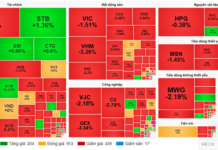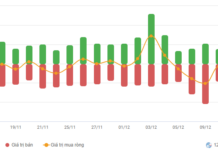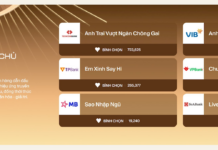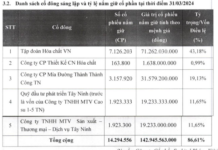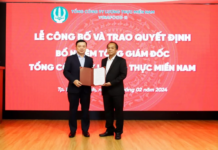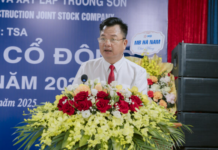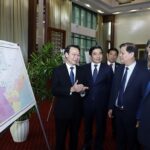Compressing a 3-4 Year Project Preparation into 6 Months
At the Ministry of Transport’s monthly task deployment conference and key task briefing for December 2024, Mr. Luu Quang Thin, Deputy Director of the Planning and Investment Department, shared that based on the needs registered by investors/project management units, the Ministry has formulated a public investment plan for 2025 with a capital requirement of approximately VND 89,211 billion.

Drilling work for a section of the North-South Expressway project phase 2021-2025.
Mr. Thin emphasized, “2025 is an exceptionally important year, being the final year to accomplish the goals set by the 13th National Party Congress. We aim to commission nearly 1,000 kilometers of expressways and prepare for investing in several large-scale projects, including the high-speed railway and the railway connecting to China, despite facing imminent changes in organizational structure and personnel.”
To accomplish the disbursement goals for 2025, the Planning and Investment Department is collaborating with investors and project management units to advise the Minister on allocating the 2025 plan for these projects before December 31, 2024.
The Department instructs investors and project management units to devise detailed monthly and quarterly disbursement plans, identify critical paths for disbursement, and report to the Ministry before January 31, 2025, to serve as a foundation for management and performance evaluation.
Regarding the North-South high-speed railway, the Railway Project Management Board is expediting tasks related to selecting consulting contractors for the feasibility study report. Meanwhile, the Transport Development and Strategy Institute is finalizing the proposal for developing railway human resources and the railway industry.
The Laos-Hanoi-Haiphong railway, with a total investment of about USD 8.37 billion, typically requires 3-4 years for investment preparation. However, the Central Committee and the Prime Minister’s directive to commence construction in 2025 presents a significant challenge.

The Ministry of Transport aims for Vietnam to have 3,000 kilometers of expressways by 2025.
Thus, the Planning and Investment Department requests that the Railway Project Management Board submit the pre-feasibility study report to the Ministry in December 2024 to gather feedback from relevant agencies. They should also coordinate in establishing a State Appraisal Council and complete the appraisal of the pre-feasibility study report before February 28, 2025. Furthermore, they need to finalize the dossier for the Government to submit to the National Assembly before March 31, 2025, with the National Assembly expected to approve the investment policy in May 2025.
The Vietnam Railway Authority, in collaboration with the Railway Project Management Board, is tasked with perfecting the investment proposal dossier and submitting it to the Ministry in December 2024 to seek feedback from concerned agencies. They are striving to report to the Politburo in March 2025.
Planning to Disburse VND 87,000 Billion in 2025
According to the Planning and Investment Department’s report, as of the end of November 2024, the Ministry of Transport has disbursed approximately VND 52,750 billion, achieving 70% of the assigned plan. While this figure is lower than the same period last year (75% in 2023), the Ministry is still maintaining a higher rate than the national average of 60.4%.
To fulfill the disbursement target as directed by the Government and the Prime Minister (a minimum of 95%), the Ministry needs to disburse approximately VND 23,000 billion in the remaining two months.
Mr. Luu Quang Thin acknowledged, “This is a formidable challenge, requiring the dedication and determination of investors and project management units, along with close supervision and monitoring from the Ministry’s agencies.”

The Minister of Transport emphasizes the need to mobilize all efforts to complete Long Thanh International Airport by the end of 2025.
At the conference, Minister of Transport Tran Hong Minh instructed that regarding the North-South high-speed railway, which has been approved in principle by the National Assembly, the units must concentrate even more on executing the tasks for December 2024 and early 2025. He stated, “We must work not only during the day but also at night. In addition to promptly finalizing the procedures for selecting consultants to prepare the feasibility study report, it is necessary to consider strengthening the resources and capabilities of the project management unit, which is expected to handle a considerable workload for the North-South high-speed railway project. To ensure progress and quality, we should also learn from the experiences of developed countries with robust high-speed railway systems regarding management and implementation methods. We can explore establishing a chief engineer or architect position.”
The Minister urged the specialized management agencies to collaborate closely with investors and contractors to find solutions for shortening the time required for soil loading at the Can Tho – Ca Mau section of the project. He emphasized that any acceleration of the schedule must be accompanied by a guarantee of quality. He also instructed them to resolve obstacles related to land clearance for certain projects, such as Bien Hoa – Vung Tau and Khanh Hoa – Buon Ma Thuot.

The Laos-Hanoi-Haiphong railway is set to break ground in 2025.
Regarding the Long Thanh International Airport project, the Minister assessed that the progress of component projects 3 and 4 has not met expectations. He proposed establishing a task force to coordinate and address challenges. He also instructed the Vice Minister in charge to regularly inspect and supervise the progress, emphasizing that any resolvable issues at the site should be addressed immediately. The Minister set the goal of completing the entire project synchronously by December 31, 2025.
Additionally, the Minister advised units to actively coordinate with relevant agencies and investors to initiate crucial connectivity projects promptly. These include the expansion of the Ho Chi Minh City – Long Thanh expressway section, the Trung Luong – My Thuan expressway under the PPP model, and projects that have stalled or slowed down, such as Hanoi – Yen Vien – Pha Lai – Cai Lan.
Highlighting the directive to commence the Laos-Hanoi-Haiphong railway in 2025, Minister Tran Hong Minh requested that the relevant unit clarify the investment-related contents of this project to serve as a basis for the Ministry’s leadership to work with partners and advance the implementation process.
Concerning projects in the investment preparation phase, the Ministry is determined to expedite procedures, initiate projects as scheduled, and disburse the allocated capital, especially for projects utilizing surplus revenue from 2022 with urgent timelines and substantial capital allocations for 2024. These include the Cam Ly Bridge and tunnel projects on National Highway 1 (Railway Project Management Board), the Cho Moi-Bac Kan expressway (Project Management Unit 2), and the road connecting Noi Bai-Lao Cai Expressway with Tuyen Quang-Phu Tho (Phu Tho Department of Transport).
Furthermore, the Ministry is proceeding with investment preparation for other significant projects and collaborating to address issues with stalled or delayed projects to prevent wastefulness.
The Rising Economic and Cultural Hub Along the Coast
Minister Du Duc Duy emphasized the immense diversity and richness of Vietnam’s marine resources, which present enormous potential for the development of numerous vital economic sectors.
“Vietnam’s Strategic Advantage: Prime Minister Vows to Develop Semiconductor Industry”
“Prime Minister Pham Minh Chinh emphasized the development of the semiconductor industry as a strategic breakthrough and a key task for Vietnam. He underscored this endeavor as a necessity and a resolute commitment, leveraging the country’s unique potential, prominent opportunities, competitive advantages, and strategic vision. The directive involves assigning general and specific tasks and solutions to ministries, sectors, and local authorities.”
Commencing the Laos Cai-Hanoi-Haiphong Railway Project in 2025
The Ministry of Transport has unveiled its ambitious investment plans for 2025, with a staggering 87 trillion VND earmarked for infrastructure development. Headlining these plans is the proposed Laos Cai-Hanoi-Haiphong high-speed railway, an unprecedented project boasting a total investment of 8.37 billion USD.
What’s Changing with the New 2025 Driver’s License Regulations?
The process of exchanging pre-2025 driver’s licenses has undergone significant changes due to the updated Road Traffic Safety and Order Law.


